CAPE TOWN, SOUTH AFRICA - On the outskirts of this South African beauty is one of its oldest suburbs — Woodstock — where the run-down buildings have mostly been gentrified by creatives. Their workshops border crumbling houses that for generations have been inhabited by fishermen and factory workers. Now, its hip urban coffee shops sell antique motorbikes alongside freshly roasted beans … market stalls hawking toy cars conjured from Coke cans … restaurants that out of the blue join the ranks of the world’s Top 100.
On Saturday mornings, Capetonians flock to the stripped-brick factory, where local craftspeople sell their wares — ceramics at Imiso, hand-made herbal soaps at Karoo Moon. Nearby, tents house the city’s busiest food market, piled high with treats like koeksisters (plaited doughnuts soaked in cinnamon syrup), craft beers, lamb-and-apricot samosas, hot pickled fish. Then there’s the theatre of food at The Test Kitchen and the far-reaching views at The Pot Luck Club for pan-African and Asian sharing platters.
At 66 Albert Road, The Woodstock Exchange is where you’ll find local furniture stars Pedersen + Lennard and fashion favourites Made in Maboneng and, at 160, The Woodstock Foundry, John Vogel’s modern riempie furniture workshop and the popular Dear Rae jeweller. Galleries, too, are here, with some of the biggest names in the South African art world now within a few blocks.
Inside this tightly-knit community is a vibrant group of street artists. In 2009, local artist, Freddy Sam, began a street art revolution in Woodstock. It all started when he asked Woodstock residents if they would allow him to paint on open walls — showing them the art before painting and getting their permission first. This inspired other artists from around the world who moved into the neighbourhood and began working in the area — the project grew tenfold when Adidas got involved.
This art movement gave rise to Township Art Tours (http://townshiparttours.co.za/), a responsible tourism initiative run by Juma Mkwela, himself a local artist who created some of the street art on display in Woodstock. We met at the Woodstock Exchange (a creative centre for fashion designers, photographers, printers, illustrators and film directors) and proceeded on a 90-minute tour of some of the best street art I’ve seen outside of London.
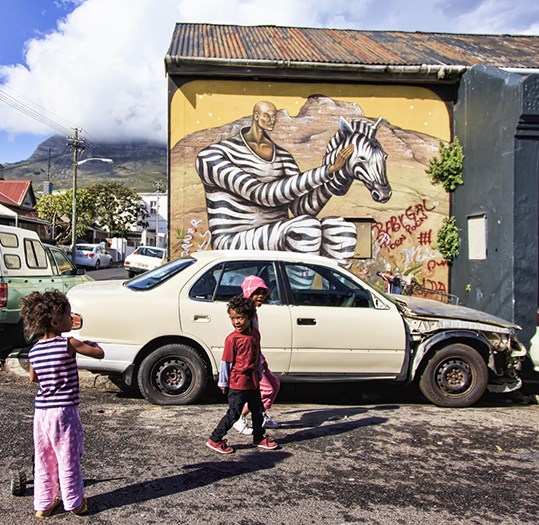
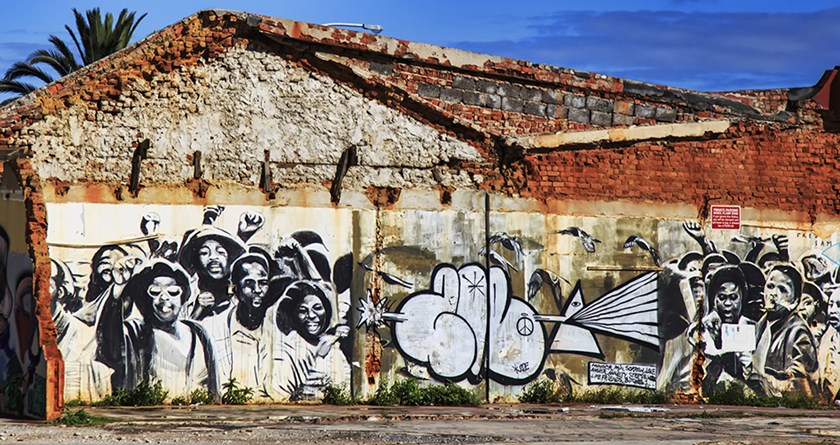
Above: The street art on Woodstock can be controversial but it's always beautiful.
Whilst walking around the dodgy neighbourhood it became clear the whole community knew Juma and everyone "stoep-sitting" wanted to say hello. We met a few locals, a couple of gangsters and the police, who stopped to say "howzit" — even the handcuffed man in the back of the cruiser gave us a toothless grin. There were a lot of kids, too, playing in the street under the collective watch of the community.
Woodstock is an area in transition. The lower part has always been poor and rough but blessed with outstanding architecture. Then one block away, and bam! you’re in the hippest quarter in town with farm-to-table breakfast spots joining cafés, galleries and interior-design shops.
Exploring Woodstock’s open-air galleries and colourful side streets provided a glimpse into this eclectic suburbs’ different facades, which tells stories of its people. Exploring the works of world-renowned artists such as Faith47, Falko One — both locals — and international artists Know Hope (from Israel), Jaz (Argentina) and Gaia (U.S.), I soon learned street art is not merely an embellishment for the area’s buildings, it acts as a catalyst to positive socio-economic change within the community.
I’m introduced to Black Khoki’s work — the "Rainbow Nation" painted against a wall in a narrow alley beside a house. The homeowners put an iron security gate in front of it, protecting it from vandalism. Ironically, this turned it into a "Rainbow Nation of Robben Island" — as introduced by Desmond Tutu, who was imprisoned there with Nelson Mandela. Black Khoki is a local artist, from Side Street Studios (http://www.sidestreet.co.za), who’s inspired by African masks and faces. As is Conform, who has a different take on them.
Gisela (from Argentina) sees art in the immune system.
Justin Southey professionally recycles furniture in Woodstock and installed "The Door" from his off cuts. The large colourful depiction of a wolf is created by Nard, an artist from Muizenberg who feels we’re no different to animals. Her colours reflect the diversity of cultures. The two trees with one root is by Faith47, demonstrating we are all connected and share the same roots.
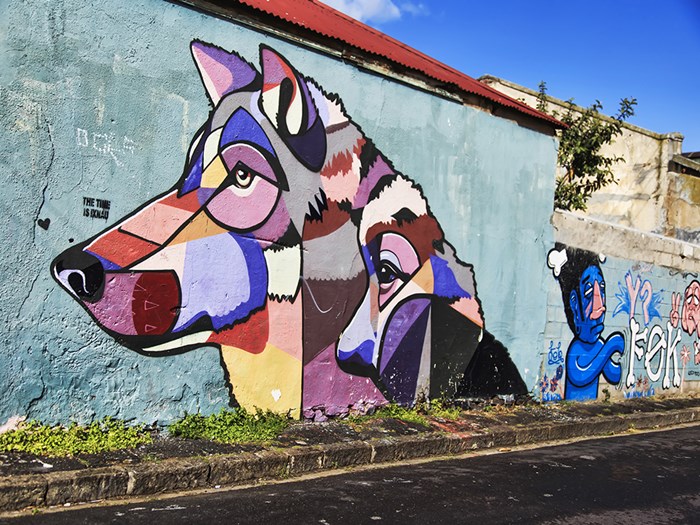
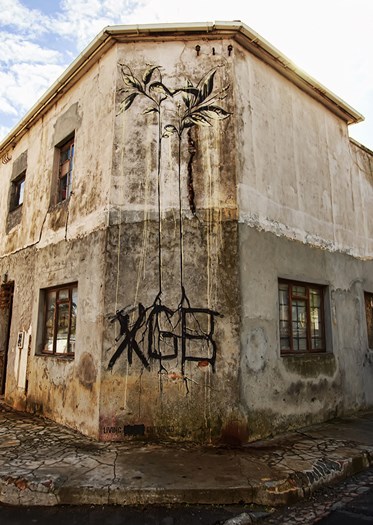
Above: Walking around Woodstock is like being in an open-air museum.
Masai Louis (from London) is inspired by the world’s endangered animals. “Here his moral depicts South Africa’s national bird – the Blue Crane,” says Juma. “Like this Rothschild giraffe, there are just 2,500 left in the world.”
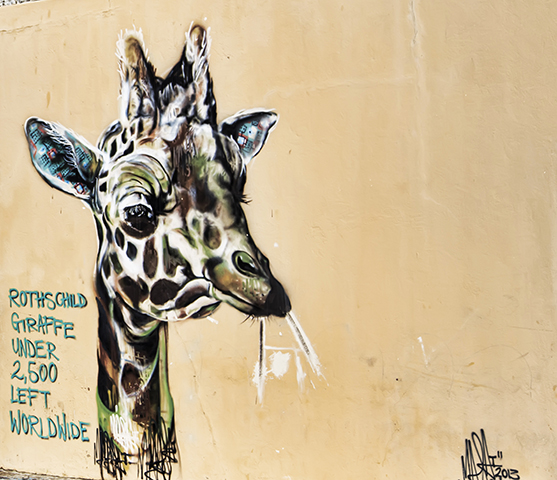
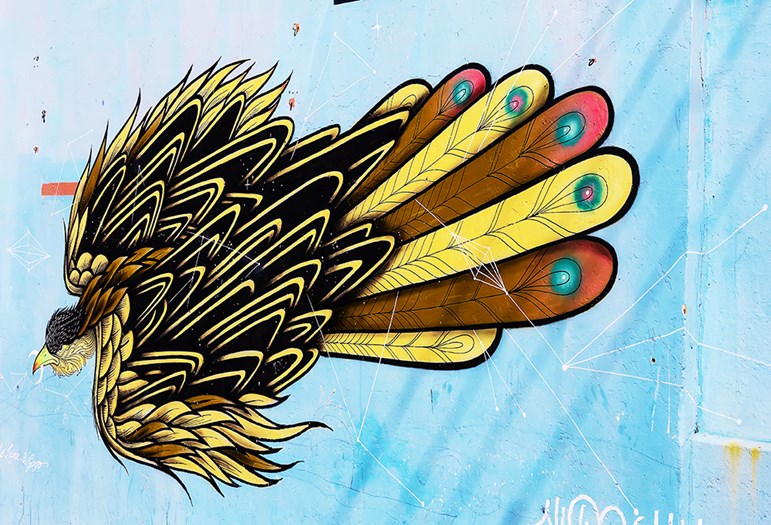
Above: Playful street art abounds in Woodstock.
I linger at a "Save our Rhinos" artwork which demonstrates that in 2005 we lost 15 rhinos to poachers, 2012 took 668. In 2013, we lost 746 in just 70 days.
I’m presented to "Confusion" by Japan’s Yuminaz Toshimur — himself a tsunami survivor. His mural demonstrates his inner turmoil. Interezni from the Ukraine feels humans and animals are the same. “If you kill an animal you may find your brother inside,” says Juma.
“Five artists collaborated to create this series of bird morals,” says Juma. “They travel to different cities painting murals to raise funds for a local orphanage.” Across from this mural is its inspiration — a house that has a lot of crated homing pigeons. As if in support, the telephone wire above has an obligatory line of pigeons sitting on it.
No Hope from Tel Aviv painted "Tug of War", which has personal meaning to him as it’s about fighting for your country. The vivid blue graffiti against a green wall is by Gregoire, a 10-year-old who wants to be an artist. John’s mural of a woman is inspired by elephants swimming underwater.
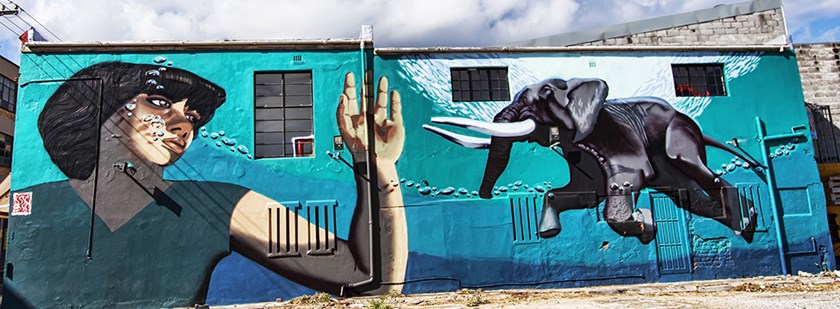
Above: The artists' African roots are always in display.
“You see,” reflects Juma, “art activism is a platform for inspiration and change. It’s all around us.”
Information
Clifton, an exclusive residential area of Cape Town and home to some of the most expensive real estate on the continent, has a seaside hideaway that’s a closely guarded secret by those in the know. Cape View is a quiet, intimate property. It’s contemporary colonial styling is cocooned between the magnificent Twelve Apostle mountain and the south Atlantic Ocean. All five deluxe suites, and two fully equipped two- and three-bedroom family suites, with original artwork and photography that depicts the story of Africa, are spacious and sea-facing, each opening onto a private balcony with uninterrupted sea views.
www.capeviewclifton.co.za/ For further inspiration see
www.capetown.travel/ Township Art Tours (
townshiparttours.co.za/)